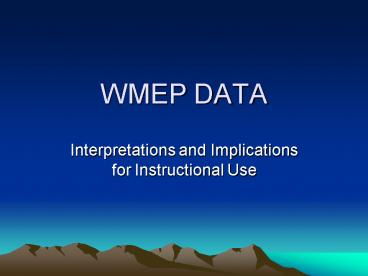WMEP DATA - PowerPoint PPT Presentation
1 / 30
Title:
WMEP DATA
Description:
Basic Skills Test (BST) Demographics. Students. Staff. 2003 Adequate Yearly Progress Status ... and race/SES comparisons based on MCA and BST results. ... – PowerPoint PPT presentation
Number of Views:41
Avg rating:3.0/5.0
Title: WMEP DATA
1
WMEP DATA
- Interpretations and Implications for
Instructional Use
2
Step 1 Extrapolation from Website
- Data were taken from the online website during
the months of April and May, 2003. - Data were available for 2000, 2001, and 2002 with
limited data (at that time) for 2003.
3
http//education.state.mn.us/stellent/groups/publi
c/documents/translatedcontent/pub_education_about.
jsp?DISTRICT_NUM6069DISTRICT_TYPE62SCHOOL_NUM
000NAMEWESTMETRO EDUCATION PROGRAM
- WEST METRO EDUCATION PROGRAM District
- 5701 NORMANDALE RD. 302 EDINA , MN 55424
DISTRICT NUMBER AND TYPE 6069-62 - PHONE (952) 848-4020 DIRECTOR MITCHELL TROCKMAN
Map to this school - Test Results
- Minnesota Comprehensive Assessments (MCA)
Basic Skills Test (BST) - Demographics
- Students Staff
- 2003 Adequate Yearly Progress Status
4
Step 2 A coding sheet for each school district
was then created so that all variables (the grade
level tests for Reading, Math, and Writing) could
be placed on coding sheets for statistical
comparisons for each year by race comparisons and
race/SES comparisons based on MCA and BST
results. INVERSE calculations, in some cases,
were coded on the sheets to find the largest
spectrum of deficiencies.
5
(No Transcript)
6
Race/SES Comparisons
- Eligible refers to eligible for free/reduced
lunch (indicator of lower SES) - Not Eligible refers to those students who do not
receive free/reduced lunch - (indicator of higher SES)
7
(No Transcript)
8
Race Comparisons
- Although results were available for other
ethnicity comparisons, this study utilized the
most extreme portions of available data to
measure the achievement gap - This study utilized a causal-comparative research
design that is characterized by ex post facto
(already existing) data with 2 groups one in
whom a characteristic is present, another in whom
it is present to a lesser extent - The characteristic, in this case, was passing the
test.
9
(No Transcript)
10
Step 3 Ratio Data
- In order to effectively measure the achievement
gap, comparison data, both race/SES and race,
were converted to ratios through simple division
11
(No Transcript)
12
The higher the ratio proportion, the greater the
achievement gap
13
Step 4 Bar Charts
- For every test comparison, a bar chart was
created by year and by district. - In this regard, it seems that the achievement gap
is most visually represented. - However, in order to determine the efficacy of
the comparisons, statistical tests were also
necessary.
14
Math TrendPercent Below Grade Level/Failing
15
Read TrendPercent Below Grade Level/Failing
16
Ratios
17
Step 5 Statistical Tests
- Due to the number (n) within a population tested,
3 tests were used to efficiently compare the
statistical significance of the means - T-tests
- Z-tests
- Fishers Exact test (for smaller populations)
18
Z for one-tailed test at
- .001 level of significance 3.08
- .01 level of significance 2.33
- .05 level of significance 1.65
- In charts created for each test, the bottom line
is that numbers above 1.65 for z-tests or p
values less than .05 would be considered
statistically significant numbers below 1.65
were NOT statistically significant and therefore
discarded in terms of the gap - In the following chart NOT statistically
significant
19
(No Transcript)
20
Step 6 Interpretations
- After insignificant data were discarded,
interpretations were made on the magnitude of the
achievement gap. - Those trends and patterns that were most
noteworthy were highlighted in order to
generalize the information for instructional
purposes.
21
Step 7 Generalizations
- For instructional purposes, data were sorted
hierarchically by greatest need. - Every school district was different based on
grade level and test patterns by discipline
category reading, math, writing.
22
- In most districts, however, READING and WRITING
were the most noted gaps that need the most
direct assistance. - This conclusion was drawn by comparing
statistically significant ratios side by side, - much like taking an eye exam.
23
Math
24
Reading and Writing
25
When placed side by side, it is evident that one
group contains higher ratios than the other.
26
Thus, those strategies most suited to reading and
writing improvement/acceleration, would be first
the first concentrated series in the Course of
Study for WMEP.
- The foundations for this instruction are based on
5 critical experiences for reading - Reading Goals
- Writing Goals
- A definition of literacy that encompasses more
than language arts, but symbology, as well - Literacy to construct, create, and communicate
meaning in a variety of representational forms
(Eisner).
27
Possible Strategies
- Read-Talk-Write (Nessel Baltas) for
comprehension monitoring - Taxonomies (Rothstein Lauber) to build
vocabulary - Phonics Hopscotch (Mann) to build sight word
vocabulary in lower grades - Thinking Maps (Hyerle) for mapping cognitive
processes including concept development,
classification, description, analogous thinking,
part-whole relationships, cause-effect, and
comparison-contrast
28
- As time progresses, math strategies would be
addressed and added to ensure continued
development and achievement.
29
Step 8 Rinse and Repeat
- The role of data then becomes a crucial factor in
making data-driven decisions to tailor
instructional techniques to - Improve test scores
- Use language, culture, and cognition as a medium
for instruction - Differentiate instruction not just by ability but
by interest and learning styles - Make real world connections to events occurring
in classrooms by establishing affective value
through universal concepts and themes - Hence, post evaluation data will allow this
partnership to - revisit curriculum and instruction, and
- measure growth through NUA participation based on
state standards
30
Finé































